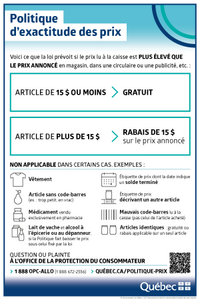Merchants have obligations regarding price indications and accuracy. Whether there is a pricing error at checkout or an inaccurate pricing display, you have recourse options.
Merchants have different rules to follow whether they indicate the price on each item or in proximity of the goods (e.g., on the shelves). In the latter case, merchants must abide by the Price Accuracy Policy.
Prices shown in proximity of the product
The Price Accuracy Policy allows customers to be compensated in case of a pricing error at the register. If the price of the article you are buying is higher at the register than what was advertised, the merchant must:
- give you the item for free if the item costs less than $15;
- sell you the item at the advertised price, minus $15, if the item costs more than $15.
Compensation does not apply
The Price Accuracy Policy also does not apply, for example, to the following products:
- Items without a barcode, such as fruits and vegetables sold in bulk, goods too small to have a barcode, etc.;
- cow’s milk, if applying the Price Accuracy Policy would mean it would be sold below the minimum price set by law (web page in French only);
- alcohol products sold in grocery stores or convenience stores, if applying the Price Accuracy Policy would mean it would be sold below the minimum price set by law (in the case of a pricing error at a Société des alcools du Québec outlet, the compensation provided for under the Policy applies);
- tobacco products.
Prices shown on individual items
If the merchant decides to individually tag each article, they don’t have to abide by the Price Accuracy Policy. However, they must sell items at the advertised price, never at a higher price. For example, an item tagged at $5 must be sold at that price, even if the register shows $7.
What if a single item shows two different prices? The lower price prevails.
Always check the receipt before leaving the store
To avoid having to go back to the store to recover a few dollars, make sure you always check the receipt before leaving the store. However, if you only notice an error when you’re back home, you can go back to the store. It’s never too late to assert your rights.
The Prices and Discounts section provides all the information about the pricing of items, the display of prices, and the Price Accuracy Policy.
Merchants must display the selling price of every item sold in their store.
To be exempt from this obligation, merchants must, among other things, display an item’s price on its shelf (the price must be displayed close to the item) and use an optical reader to scan purchased items.
Exceptions regarding the price on each product
The law provides for exemptions regarding the individual product labeling rule. Merchants must clearly and legibly display prices close to items that are exempt from the above-mentioned regulation. For example:
- Unpackaged items with a price calculated according to a unit of measurement (for example, fruit sold by the kg);
- Foods that are not packaged before being sold (for example, a $6 melon);
- Frozen foods;
- Items sold for $0.60 or less;
- Items sold in a vending machine.
The page In-Store Price Labeling and Indication Rules presents a complete list of items that are exempt from the regulation.
Special rules regarding price indications for food products
Grocery stores, convenience stores and any other businesses that sell food products must abide by certain price indication standards. Consult the page Special Rules Regarding Price Indications for Food Products to find out more.
What happens if a merchant does not display prices or displays erroneous prices? Or what if a merchant refuses to apply the Price Accuracy Policy or to have you pay the lowest price, in cases where the Policy does not apply?
You can file a complaint with the Office de la protection du consommateur. The Contact Us page lists our contact information.
Last update : May 26, 2025
Was the information on this page useful to you?
The information contained on this page is presented in simple terms to make it easier to understand. It does not replace the texts of the laws and regulations.











Thank you! Your comment was submitted successfully.